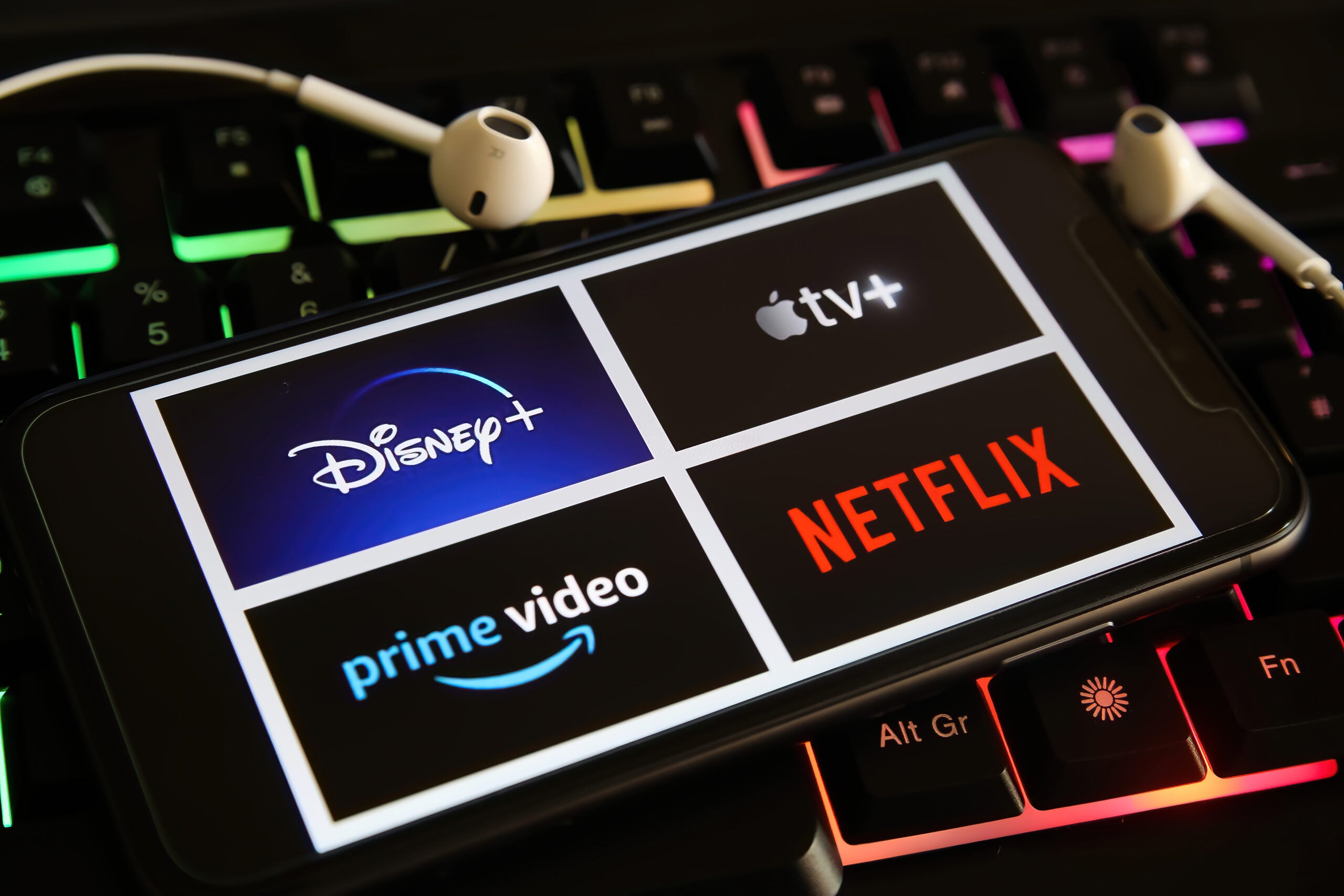
The streaming wars rage on. When Netflix unveiled its quarterly results in July, it showed just how much at risk the king of online video streaming is of being overtaken by rivals like Amazon Prime, Disney+ and Apple TV. While the pandemic created ample opportunities for a plethora of streaming services to flourish, the battle for subscribers has now entered a new phase.
Until now, the war has been fought predominantly in the realm of content. By providing high-quality series and blockbuster movies, several platforms have been able grab a slice of the pie. Content has been king. That has, as Paramount Studios’ Kelby Clark noted back in 2019, made it no different from the media battles fought in the past.
However, the times are, to quote Bob Dylan, a-changin’. Several factors have transformed the market. Chief among them are the end of the Covid-19 restrictions combined with the spiralling cost of living crisis. Together, they have shrunk the pie available as subscribers look for ways to cut costs. Now, Netflix, Apple, Amazon and Disney must find new ways to secure their bottomline.
“No longer can these services purely rely on their content in the battle for top spot,” Stefan Lederer, CEO and co-founder of online video startup Bitmovin, tells Verdict. “As pockets are pinched and people look where they can cut back, consumers will be looking at other key criteria in choosing their streaming service.”
Where does that leave the big players in the streaming wars?
“The king of streaming” at risk of losing its crown
Netflix is the king of video streaming. However, it has somewhat become a victim of its own success. Marc Randolph and Reed Hastings founded Netflix in 1997 as a DVD rental company. Randolph left the company a few years later, leaving Hastings to take the reigns as CEO.
How well do you really know your competitors?
Access the most comprehensive Company Profiles on the market, powered by GlobalData. Save hours of research. Gain competitive edge.

Thank you!
Your download email will arrive shortly
Not ready to buy yet? Download a free sample
We are confident about the unique quality of our Company Profiles. However, we want you to make the most beneficial decision for your business, so we offer a free sample that you can download by submitting the below form
By GlobalDataIt was under his leadership that Netflix became one of the first companies to offer an online subscription video streaming service in 2007. Since then Netflix has continuously proven the viability of the model.
While that provided it with the first mover advantage, it also paved the way for rivals like Amazon, Apple and Disney. It showed its competitors how it could be done.
The streaming service grew rapidly over the years. One key moment occurred in 2010 when it acquired the right to stream the hit TV show Breaking Bad. Netflix passed another milestone in 2013 when its own studio produced the hit show House of Cards. A steady stream of hits like Stranger Things, Daredevil and Squid Game has cemented Netflix’s position as streaming tour de force.
It was with this background that it entered the pandemic in 2020. During the course of Covid-19, Netflix grew by “36 million subscribers in 2020”. Share prices increased by 30% in 2020 as investors bet on its ability to benefit from people spending more time indoors and more time streaming, the BBC reported at the time.
It’s no mystery as to why it grew. Over the course of the coronavirus crisis, governments introduced social restrictions to limit the spread of the contagion. That left people looking for ways to entertain themselves at home. Streaming platforms like Netflix and its rivals were perfectly placed to leverage the pandemic to their own advantage.
However, things have gotten tougher for Netflix. The $98bn powerhouse’s latest quarterly results paint a bleak picture.
Bad times at Los Gatos
The Los Gatos-headquarted company’s revenue rose 8.6% to $7.9bn in the second fiscal quarter, compared to last year. It showed a 5.5% increase in annual subscribers, but also revealed that streaming giant had lost close to one million subscribers in Q2 2022, despite spending $4.7bn on additional streaming content.
The subscriber loss has only added to Netflix’s dismal year, according to analysts. Netflix was hit by market saturation and deeper living crisis costs in its core markets.
Francesca Gregory, analyst at GlobalData, tells Verdict that these subscriber stats painted a bleak picture. Netflix has become more vulnerable in recent years and must make changes to differentiate itself from its rivals, as Verdict has reported in the past.
“[Netflix’s] unwillingness to change has made it slow to respond to industry headwinds, leaving it in a position where it now needs to water down its original product to retain its market position,” Gregory says.
However, market watchers suggest it’s too early to declare Netflix out for the count.
“The death of Netflix was grossly exaggerated – there is no Great Unsubscribed,” Tien Tzuo, CEO and founder of software for subscription services launch company Zuora, tells Verdict. “Data continues to show that churn or cancellations for subscription businesses is actually lower today than before the pandemic.”
While arguing that things aren’t as bad as they might look, Tzuo adds that Hastings shouldn’t relax just yet.
“[Netflix finally] has competition,” he says. “They are still the king of streaming, but to continue to lead, they can’t just focus on subscriber acquisition; they have to focus on keeping their current subscribers coming back.”
To win the streaming wars, Tzuo believes Netfliz must “rethink the binge, offer annual plans and unbundle their content to create smaller, cheaper and ad-free offerings.”
That still leaves Netflix at risk of being overrun by competitors that don’t rely on video streaming for their survival. Disney, Amazon and Apple’s makes their profits from other parts of their business.
“In contrast, both Disney+ and Amazon Prime are extensions and complements respectively to a wider corporate offering and could exist as loss-makers without the same consequences that Netflix would face if it made huge losses,” Måns Ulvestam, co-founder of global podcast company Acast, tells Verdict. “Consumers are also inherently more likely to cancel their Netflix subscription but keep their Amazon one, which offers them a wider range of benefits beyond video streaming.”
Disney+ has emerged as a big threat
Disney has emerged as a major threat to Netflix’s future. Its streaming service packs a solid punch due to the one-two combo of Disney’s deep pockets and its content. It is powered by the entire back catalogue of the Disney empire. Over the years the house of Mickey Mouse has acquired giant studios that now fuel the streaming service with content.
For instance, Disney acquired Marvel Entertainment in 2009, Lucasfilm in 2012 and 20th Century Fox in 2019. These deals empowered the entertainment giant with a huge advantage when Disney+ was rolled out in late 2019: it came with exclusive streaming rights to fan favourites like the Marvel Cinematic Universe and Star Wars.
On top of that, Disney has operational control of Hulu, thanks to buying 33% of the channel via the Fox deal.
Disney is also unafraid of adding to the Disney+ catalogue: the streaming service spent $25.26bn on content in 2021, a figure that is likely to rise to $33bn in 2022, according to Fierce Video.
The streaming service arguably also had some luck thanks to the pandemic. Disney+ was more than ready to step in and grab the spotlight as people looked for ways to entertain themselves during lockdown.
Covid-19, coupled with its exclusive franchise or channel rights and original streaming, provided Disney with a “front-of-mind presence once reserved solely for Netflix,” as Collider reporter Lloyd Farley put it.
But Disney+ wasn’t the only Netflix rival to grow into a tangible threat over the past few years.
Amazon is in prime position to fight the streaming war
Amazon has been busy building out its Prime Video subscription service since it first saw the light in 2006. Back then it was called Amazon Unboxed. It allowed users to download movies from major studios.
It transformed into Amazon Prime Video following Amazon’s acquisition of UK DVD rental and online movie company LoveFilm in 2011. Amazon has since continued to expand its video streaming service, transforming it into a strong contender for the crown.
It has done so through a string of deals and acquisitions. Amazon’s latest major deal was its $8.5bn acquisition of Metro Goldwyn Mayer earlier this year. This deal included the MGM studio, more than 4,000 movie titles and 17,000 TV episodes, according Forbes. It was a slightly risk move, as the company paid a 60% premium over the $5.5bn market cap for MGM studio after it had gone on block in December 2021.
It has proved a lucky break for Amazon after the MGM studio went up for sale due to the impact of the Covid-19 pandemic. The studio had to postpone the release of the latest James Bond installment, No Time To Die, by well over a year due to closed down cinemas and uneasy market saturation.
The deal means Amazon now has rights to MGM franchises like James Bond and Rocky. Amazon was likely motivated to seal the deal in a bid to increase its content offering for its subscribers.
This year has seen Amazon invest $13bn on streaming content compared to Disney’s proposed increase to $33bn and Netflix’s plans to invest $17bn more in 2022.
Amazon could soon be a significant contender for Netflix’s position as the streaming war winner. The ability of Amazon to add new services such as channel subscriptions, film rentals and purchase can increase its revenue.
If Amazon’s subscriber growth is maintained in the next few quarters, the service could be close to earning $100bn by 2026-27 in subscriptions, according to crowd-sourced content service for financial markets Seeking Alpha. This would allow the streaming platform to invest $40bn on streaming in the next five years. Its growth rate for subscribers has started to grow past Netflix’s rates with the release of big budget shows like The Boys.
Apple TV is the third big threat
Apple TV is also a newcomer to the streaming game. Like Disney, it launched in 2019. Similarly to Disney and Amazon being big corporate empires who expanded into streaming, Apple TV is backed by a big company that doesn’t get the majority of its revenue from the subscription service.
Analysts have estimated that Apple TV “has between 20 million and 40 million paying subscribers, generating between $1bn and $2bn of annual revenue” to the company.
It is also predicted that Apple will spend $8.1bn on content for streaming in 2022. Apple has also enticed subscriber with longer free trial offers, when users pay extra for smart benefits with their iphones. Highly popular or anticipated releases for the tech company streamer include The Essex Serpent, Schmigadoon!, and Academy Award and Golden Globe winning CODA.
Apple may be looking to expand further with rumours of plans to acquire the A24 studio. In the meantime, it has patterned with the studio to produce drama thriller, The Tragedy of Macbeth.
The new streaming platform is in a unique position to its competitors as a tech rather than media company, investing in streaming. This could give Apple TV a unique technological and content advantage to better compete with its rivals.
Ad-supported tiers about to enter the streaming war
Disney, Amazon and Apple all represent a huge threat to Netflix. Unlike Netflix, the other three streaming services are only part of a bigger business. This means they can afford to invest and run their streaming services at a loss, unlike Netflix. It could help Apple, Disney or Amazon to outcompete Netflix and climb up the ranks in the streaming war.
Netflix is attempting fight back in a number of ways. Chief among them is a new ad-supported tier, developed in a tech-sales partnership with Microsoft. Its hope is to “stem the mass exodus of cash-strapped streamers,” Gregory said in recent podcast.
Neflix plans to invest “heavily to expand their multi-billion advertising business into premium television video.”
Gregory says Netflix is still behind the curve as Disney is set to launch a rival ad-supported tier, later in the year.
“Netflix must also balance integrating ads and maintaining its immersive user experience. The user experience aspect of Netflix’s offering could be threatened by its crackdown on password sharing,” says Gregory.
“The company is testing measures to prevent piggybacking in Argentina, El Salvador, Guatemala, Honduras, and the Dominican Republic. While only a test run, the risk of alienating subscribers already considering unsubscribing should not be understated.”
Regardless, Netflix arguably also has huge “underlying problems” with “unsustainable mass subscriptions,” according to Ulvestam.
“Introducing this new subscription tier completely misses the broader point as to why subscribers are fed-up, and profits teetering,” he adds.
Ads could be a problem for Netflix
Netflix has confirmed that the ads tiers won’t be rolled out until 2023, according to TechRadar. However, that hasn’t prevented a backlash of sorts.
“We have seen the backlash the leaked internal email announcing ad-supported subscriptions has caused,” Stephane Coruble, CEO of global media brands hub RTL AdConnect, tells Verdict. “Since the platform was built on the promise of never having ads, the possible implementation of these must be approached carefully.”
Coruble adds that Netflix’s green-lit ads plans must strike “the right balance and pricing model as they will need to make sure the highest paying tiers remain and find sufficient added value for their money.”
However, Coruble does support giving some power back to subscribers. He suggests ad-supported platforms could result in the introduction of lower cost subscriptions. Streaming services still need to be careful to avoid losing subscribers due to ads interruptions.
The risk of losing subscribers to ads has been reported by Appinio, a global market researcher. The researcher surveyed Brits about their preferences for paying for streaming services. It found that 53% would not want to see commercials or ads. Fifty-one percent said they are not willing to pay increased fees to avoid them.
“Customer engagement is key when introducing these ad-supported tiers, as it is not the proposition that streaming platforms have been built on,” James Manderson, general manager and VP of customer success EMEA at customer engagement platform Braze, tells Verdict. “The value of this has to be communicated really well to consumers.”
Lederer said that a form of ad-supported free subscription model could work.
“It is likely to aid subscriber retention, and lead to re-engagement with some of the lost subscribers,” says Lederer. “Offering ad-supported tiers will no doubt help retain subscribers who are on the fence.”
Are shared accounts a cause for concern?
Netflix wants to fight back by further monetising its platforms. The plan is to crack down on shared accounts and create ad free versions. The streaming giant is still targeting full year margins of around 20%. It expects to add over one million subscribers next quarter. This would add to its total of 221 million subscribers.
Amazon and Disney are not far behind 200 million and 130 million subscribers respectively, according to Seeking Alpha. While Apple has fallen a little behind its rivals, its original programming push could see it catch up quickly.
Shared accounts mean streaming platforms lose out on four potential subscribers if five people share an account. A cautious approach is needed if streaming platforms plan to crackdown on these accounts. It could put off shared account users form getting their own in the future. Users may become more likely to share accounts to avoid the new ad supported tiers.
“A crackdown on shared accounts would undoubtedly alienate subscribers, many of whom are already disgruntled,” said Ulvestam. “As streaming services continue to hike their prices, whilst simultaneously cutting down on password sharing and cancelling popular shows, consumer discontent will only get worse and more subscribers will leave”
Cost of living crisis to hit streaming services as zombie account are axed
Any increase or crackdown on shared accounts would be affected by people having less disposable income and rising costs of living.
Audience insights company, GWI said that at least 24% of UK respondents cancelled a subscription because they were paying for too many services already.
Market researcher Appinio said that 30% of Brits were cutting back on spending money on streaming. Forty-six percent said they paid between £11 and £30 a month while 14% said they paid £50 a month for streaming. The rising costs of living and subscriptions, means 20% of Brits said they spilt streaming service bills with others. it also led to 69% allowing others to share their accounts.
Ulvestam also believes zombie subscriptions mean people pay for subscriptions they no longer or do not regularly use. This means they are not getting value for money.
“For example, giving users the ability to pause their subscriptions and then resume at a later date, replacing the current approach of forcing consumers to pay for a whole month of access they may not use,” says Ulvestam. “This would also be a smart move to stem the ongoing consumer churn that streaming services are suffering from.
“Thankfully consumer protection legislation is being implemented across multiple countries to address zombie subscriptions. Close to 50% of all subscriptions are not used, and that in itself should make us think. If subscriptions were transparent to the consumer, 50% of the revenue should not be there, and this is undoubtedly concerning.”
Content release strategies become key tactic to gain more loyal subscribers
Netflix has been using more heavy-handed approaches to attempt to reverse its fortunes. This is seen in subtle changes to its evolving content strategies, according to Gregory.
“The release of season four of the hit series Stranger Things in two parts is a shift from the platform’s previous ‘all at once’ approach, encouraging both binging and high churn rates,” adds Gregory. “Quality content that is strategically released will be the key to sustained viewer engagement in the future.”
Coruble agrees with the view that Netflix’s strategic release of Stranger Things shows that content release strategies do work.
“Here you can create a pop culture moment, a period where everyone is talking about it and waiting together for the next episode to air,” he says. “Binge appeal we have seen in series like Friends and The Office, where people like to get lost in the familiar [will change]. So, there are different appeals and adapting the release strategy according to the type of content makes sense.”
Disney used a similar strategy when releasing its Emmy nominated series Only Murders in the Building. It only streamed one episode per week in its second season. It has followed a similar model to the release of Marvel shows like Moon Knight, Miss Marvel and Hawkeye as well as Star Wars series Obi-Wan and The Mandalorian.
Amazon similarly released the latest season of disturbed superhero series The Boys on a weekly basis.
Manderson suggests that it is not just about content release strategies. It is about producing personal content recommendations that subscribers may be interested in.
“It’s also about when is the right time to communicate those personal recommendations [or release content] and whether it’s best to do that through an email or on the app, to show content they are potentially interested in is available,” says Manderson. “You can learn by users’ interactions [what] the best recommendations [are] for them.”
Is investing in ‘unmissable pop culture shows’ the key to winning the war?
The need to come up with content that cements their place in pop culture has been key for streaming services in the past. While the market has changed slightly, great content remains the best way to entice users to remain loyal subscribers.
This means that Netflix, Amazon, Disney and Apple must come up with both original and studio programming. This presents a problem for subscribers as there is a lot of popular shows out there. Consumers may need to subscribe to multiple services to access all the shows they’d like to watch.
“To lock in subscribers with content they do not want to do without is definitely a successful strategy, I think the challenge lies in spotting what will be the next big pop culture content,” says Coruble. “Along with marketing against a global audience, we have seen it with Squid Game, be bold and put non-English content forward. Premium and localized content will be appreciated globally, no matter the original language.”
Up to 40% of Netflix’s content is estimated to be original programming. Market watchers estimate that this figure will grow to at around 75% by 2025. Streaming giants must also keep existing studio programming that’s popular with audiences. For example, when Netflix “shelled out $100m to keep Friends available on the site through 2019,” according to Collider. Amazon does the same with paying for external studio series like Supernatural.
Disney does not have the same kind of problems with studio programme streaming as its rivals. It owns most of the television channels and networks, which produces its non-Disney content.
Amazon created its own advantage as their platform by bundling it up with its online retail business. This means it may never need to be profitable on its own, but that there are other funds for Amazon to draw from.
Lederer suggests that whilst content is important, subscribers want more. They need to be convinced to subscribe to particular streaming services.
“Subscribers will want to ensure they can stream their content, wherever they may be even if their connection to Wi-Fi or data is low,” Lederer says. “In the era of hybrid and flexible working, subscribers’ choice of services will be influenced by whether they can stream programmes and films whilst on their commute to work without buffering and at a high quality.”
“Creating extra value through additional offerings will become a key point of differentiation for streaming services to retain and attract subscribers.”
While the streaming wars are far from over, it is clear that the fight for subscribers is only going to grow more intense. So stay tuned. You’ve seen nothing yet.
GlobalData is the parent company of Verdict and its sister publications.







